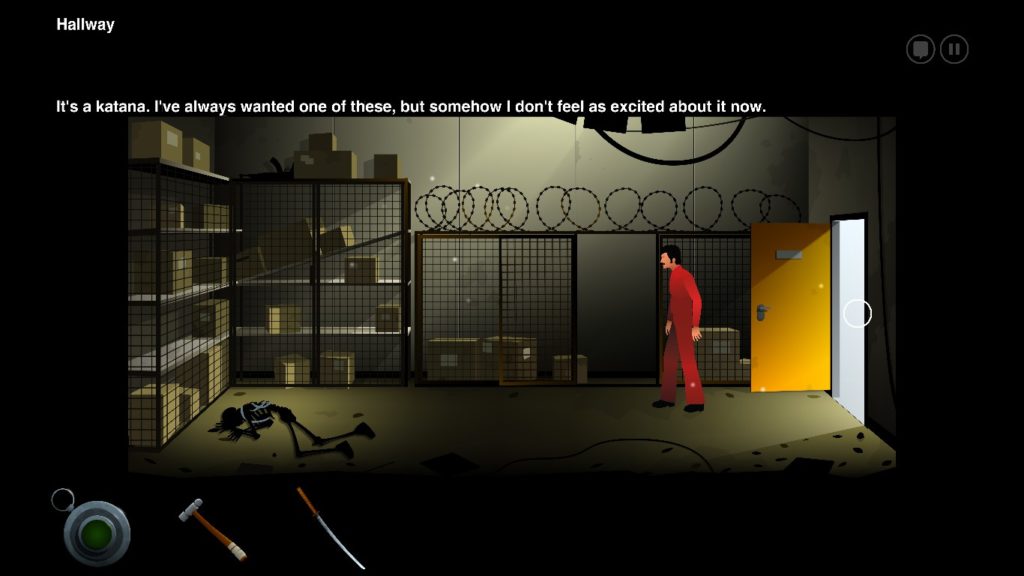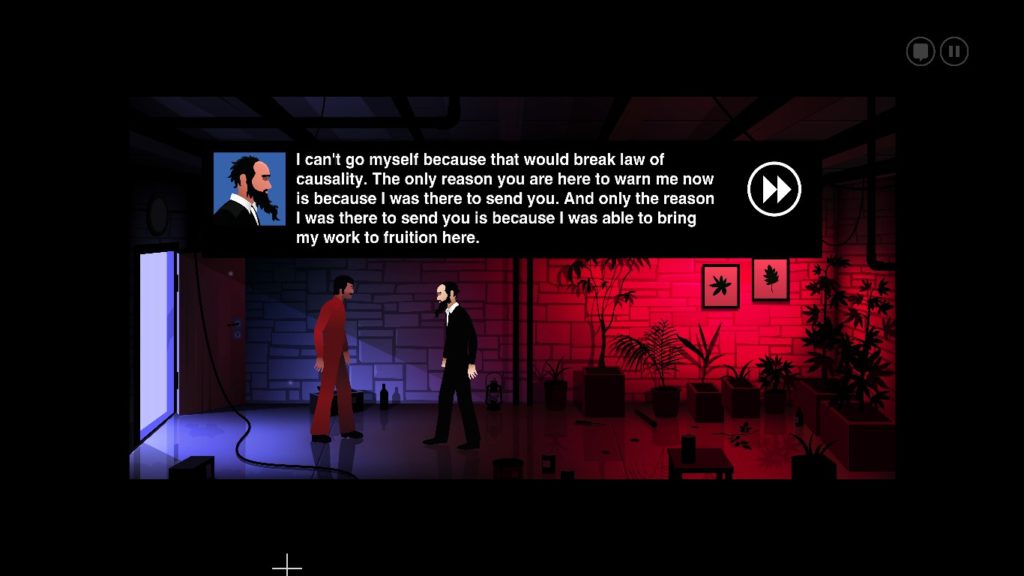From H.G. Wells to BACK TO THE FUTURE, time travel has made for a pretty well-trod genre in fiction. After all, the ability to leap forward to see what the future holds for humanity, or to go back and correct the mistakes of the past makes for some rather substantial speculation. And, sure enough, video games have also waded into these particular waters, ranging from strategy titles like the Red Alert series to legendary RPGs like Chrono Trigger, and now including today’s piece of the Big Steaming Pile, The Silent Age, developed by House On Fire.
The Silent Age casts you as Joe, a Vietnam veteran who has returned to carve out a new life as a maintenance man for Archon Technologies in 1972. When Frank, one of Joe’s fellow custodians, quits one morning, Joe is assigned to assume Frank’s duties as well, including cleaning up the laboratories. When Joe heads down there, he finds signs of violence, including a dying man bleeding out from a gunshot wound. Before the cops come to arrest you for doing the dirty deed, the man slips you a device that jumps back and forth between 1972 and 2012, and it’s up to you to escape police custody and find out just what the hell is going on at Archon.
Effectively, The Silent Age feels very much like a throwback point-and-click adventure that plays very much like it came, well, back from the mid-’90s. You click around to move Joe around the various environments, examine objects and your general surroundings, and acquire items that can be used to solve puzzles around you. This is where the big gimmick of the game, your time travel device, comes into play. Y’see, wherever you are, using the device will bring you to the exact same spot, just either forty years forward or backward, meaning that say, a door that is closed and locked in 1972 might be missing entirely in 2012, or an area that’s been flooded out in 2012 might be bone-dry and passable in 1972. This means that on top of your usual adventure game puzzle skills, you’ll have to factor in jumping between the parallel timelines to make progress, and while it’s not quite overly demanding, it does add a mostly enjoyable extra layer to the gameplay.

Now, even though this does play very similarly to a classic PC adventure game from back in the day, The Silent Age does feel more like an “Adventure Lite” kind of game, more LucasArts than Sierra, let’s say. For one, the biggest bugaboo of games like this, the sort of Adventure Game Logic where you end up having to try everything in your inventory on just about every available object in the area twice because the solutions to puzzles are so convoluted and esoteric that there’s NO conceivable way a normal human being would have drawn that conclusion, is effectively nowhere to be found. Generally speaking, the puzzles here follow a mostly normal line of reasoning, for example, at one point, you’ll have to steal an ambulance from a morgue, which requires you to find, well, the keys for the ambulance… which will be laying around somewhere in the morgue itself, in the kind of place where you wouldn’t be surprised to find the keys. Granted, that may not sound like a big leap forward, but if you’re an adventure game veteran, being able to solve problems without having to stretch the suspension of disbelief to its breaking point is a welcome breath of fresh air.
Another factor for The Silent Age‘s status as more of an Adventure Lite game is that the experience has been streamlined and condensed enough to where it is almost impossible to get bogged down or stuck. You are more or less confined to the relevant areas, so you can’t accidentally backtrack to somewhere you no longer have any reason to explore. You’ll very rarely be carrying more than two items at a time, so you won’t be trying to use a dozen different tools trying to figure out which one the game actually expects you to use in a certain spot. There are no dialogue choices, so you won’t be having to re-do a conversation with someone multiple times because you said the wrong thing at the fourth tier of a long dialogue tree. And as far as I can tell, there’s no actual way to die or otherwise get a game over, which does kinda lower the stakes somewhat, but it also reinforces that this game is about exploring and taking in the fantastic atmosphere instead of memorizing what to do, or more importantly, NOT do at any given time.
Speaking of the atmosphere, House On Fire deserves some serious credit here. 1972 looks rather drab and anesthetic, but where the visuals truly shine in their bleakness is in the 2012 timeline, where the world just looks devoid of life and color and hope, with the decaying remains of civilization surrounding you, looking like you truly are the final living thing remaining on the planet. Staircases lead to nothingness, machinery has fallen into decrepit hulks, and rotted corpses provide the only human company to be found. Joe, your character, isn’t a terribly well-developed character, and seems to have very few real distinctive traits other than a disdain for seeing dead bodies that never goes away no matter how many you come across over the course of your travels, but at least he does appear to be as mind-boggled about what’s going on without feeling like you’re in charge of a complete moron. When you fire up the game for the first time, you’re also recommended to wear headphones while playing, which I would definitely agree with, although it is definitely far from mandatory. The voice acting is another highlight, though obviously, there’s not all that much of considering how much of the game is set in the future where almost nothing has survived to speak of.

The storytelling is usually the big draw in an adventure game like this, and indeed, it’s quite competently done here for the most part. Anytime you’re telling a story about time travel, there’s almost assuredly going to be some degree of plot holes or inconsistencies that become more apparent the more you think about them and break the story down, and while that is kinda true here, on your first playthrough, you probably won’t notice unless you’re looking for them specifically, although there are some rather long-ish cutscenes, and yes, you will be hearing a couple times about the Law of Causality and some pseudo-science about time travel that may go over some people’s heads. I do feel that I should mention that I did find the end of the story to be a little bit…let’s say “overly convenient”, but this is indeed a game where the journey matters far more than the destination.
One more thing I should mention is that The Silent Age is a rather short game. It clocked in for me at a little short of three hours start-to-finish, although it take a bit longer for someone less versed in adventure games. There are ten chapters, none of which are particularly long, and as I said, the length of some cutscenes also kinda pads out the length a little bit, so the actual gameplay portion of that runtime is probably closer to two hours, which definitely adds to the overall casual feel of the game.
Overall, however, The Silent Age is a solid effort. It manages to capture the essence of an enjoyable mid-’90s P&C game while simultaneously stripping all the annoying gimmicks and speed bumps that are normally found in the genre. It is short, and not terribly involved, but that also makes it the perfect portion size for someone who’s more of a casual gamer or someone just looking for a nice diversion for a few hours, and if nothing else, it does make me want to see more of House On Fire’s work, and that speaks very well for the developers right there. All in all, I would say this is one you should try to scoop up if you’re interested in the adventure genre or you like a solid time travel story, just remember, whether in the past or the present, you can’t do much with a dull machete.
Current Price – $9.99
Is It Worth It? – It’s very good and enjoyable, but I would recommend waiting for a sale unless you are absolutely sold already.
